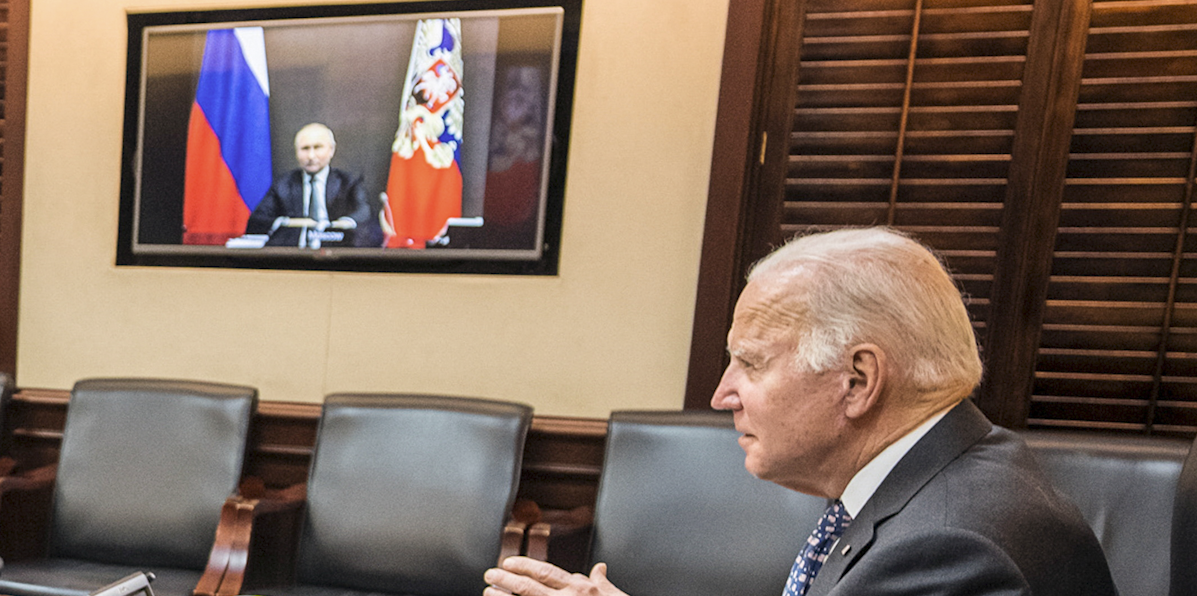America’s Choices in Ukraine
Were Biden to indicate a desire for compromise, Putin might judge that his best bet lies with the current administration.

U.S. President Joe Biden holds virtual talks with Russia's President Vladimir Putin amid Western fears that Moscow plans to attack Ukraine, during a secure video call from the Situation Room at the White House in Washington, U.S., December 7, 2021. The White House/Handout via REUTERS
For much of the period following Russia’s invasion, the Biden administration has hoped to deal Moscow a strategic defeat in Ukraine. It has believed Washington can not only block Putin’s bid to seize Kyiv and end Ukraine’s NATO aspirations, but also impose such economic misery that Russians will come to rue the invasion, China will think twice about invading Taiwan, and a Putin successor will ultimately be compelled to reapproach the West seeking forgiveness.
Such hopes are fading by the day. Russia’s economy is in greater danger of overheating from accelerated military production than strangulating from lack of trade. China now has a case-study of how to cope with sanctions. And the failure of Ukraine’s counteroffensive to break through Russian defenses has made it apparent that the most Washington can hope for on the battlefield is a bloody stalemate.
Recalibrating our hopes on a long-term stalemate would be a grave error, however. It’s true the front lines have not moved substantially over the past year. But by the metric of how many soldiers and munitions each side can send into battle, Ukraine is losing the war. With a population less than a quarter of Russia’s, suffering from large battlefield losses and millions of refugees, Ukraine has stark disadvantages waging a war of attrition. Western armament production is lagging far behind that of Russia and its partners, and the Gaza conflict is multiplying competing demands.
Even if the West sustains current levels of military and economic aid – far from a certain prospect – Ukraine will grow weaker the longer the war continues. Even if the frontlines stabilize, few donors will invest the hundreds of billions of dollars needed for Ukraine’s economic reconstruction if it must occur under the constant threat of Russian missile and drone barrages. Absent reconstruction, only a small fraction of Ukrainian refugees will return home; without robust repatriation, Ukraine will over time look more like a failed state than a fortress state.
This leaves the United States with several unappealing options. One is sending NATO troops into Ukraine to address manpower deficiencies, an option that President Biden has wisely ruled out as likely to precipitate “World War III.”
Another is privately pressing the Zelensky government to seek a settlement with Russia, as the Biden team is beginning to do. While this has obvious appeal for Biden, as it might sidestep criticism he would get for engaging directly with Putin, it is likely to fail. Placing the onus on Zelensky for seeking peace with Russia would put him at risk politically from Ukraine’s hardliners, and Russian officials insist that only Washington can address their concerns about Europe’s NATO-centric security order that underpinned Putin’s decision to invade.
That leaves direct – albeit discreet – discussions between Washington and Moscow about a compromise enabling Ukraine securely to rebuild and thrive while also addressing Russian concerns about perceived threats from NATO and its involvement in Ukraine; this presupposes some level of continued aid to Ukraine, without which Russia would have no incentives to compromise. The current Washington consensus dismisses not only the desirability of such engagement, but also its possibility, arguing that Putin has no interest in such talks.
Preemptively dismissing this possibility is unwise. Yes, Putin believes Russia has the momentum in the war and doubts Washington would negotiate in good faith. But although turning Ukraine into a dysfunctional wreck incapable of NATO membership would satisfy one of Putin’s aims, it would cause him other problems. After Putin’s near certain re-election next March, as it becomes apparent that Russia is winning the war but cannot by itself achieve peace that would allow renewed trade with the West and a growing civilian economy, Russian elites may start to agitate for extracting the country from the geopolitical cul-de-sac Putin has created. He can only address these concerns through a deal with the United States that allows détente in Europe and some easing of sanctions.
Four years of experience with Donald Trump provided Russians with little reason for confidence that he could deliver and implement any deal with Moscow that he says he wants to strike. If Biden were to indicate a desire for compromise, Putin might well judge that his best bet for making a deal stick lies with the current administration. It’s time to test that possibility.
George is the Director of Grand Strategy at the Quincy Institute for Responsible Statecraft.
